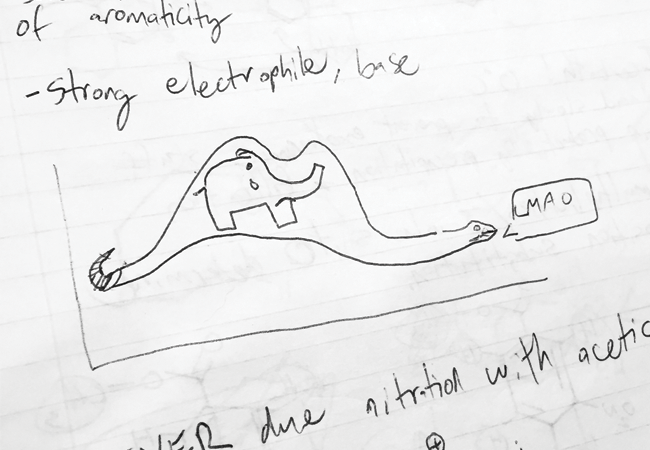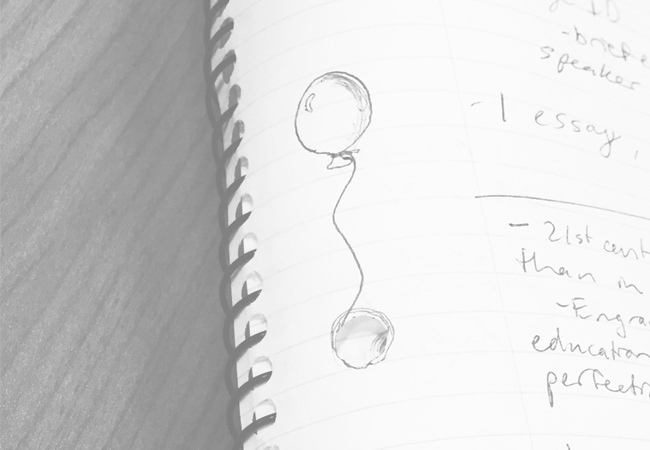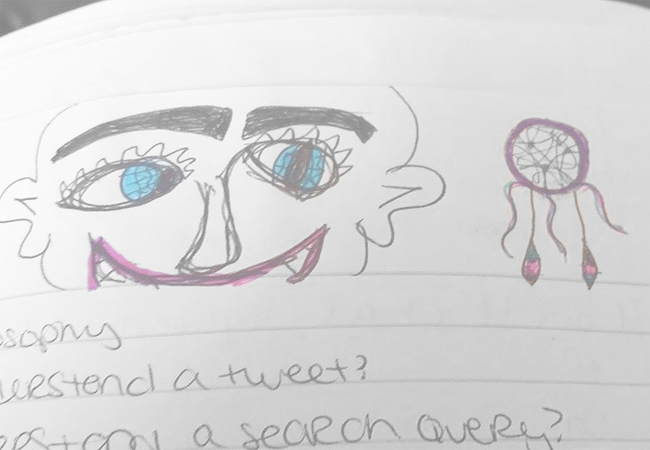Whether it’s a few spirals alongside notes on Waterloo, a school of goldfish swimming toward your supply and demand graph or a snake digesting an elephant in a free energy diagram, doodles can spice up any page of lecture notes. But what if those stick-people were more than just college-ruled scribbles? We talked to Art Theory and Practice Professor Allison Wade, who critiqued them as fine art.
Marissa Hastings, Weinberg sophomore:


“This is from my econ class,” says Weinberg sophomore Marissa Hastings. “If I get hungry at the end of the lecture, because that class ends at five or so, I’m thinking about food.”
Professor Wade:
“It’s interesting since they’re drawn from various points of view. You’ve got the bird’s eye view of the pizza and you’ve got the more straight-on view of some of the other elements. The looseness with which these are drawn is compelling.”
Aidan Manaligod, Bienen sophomore:


Bienen sophomore Aidan Manaligod doesn’t doodle much in class to avoid being distracted from the material. When he does doodle, however, it’s usually pertinent to the topic.
“This is from orgo last year,” Manaligod says. “I think this is a free energy diagram and someone said it looked like a picture from The Little Prince.”
Professor Wade:
“They’re happening within the text themselves. So the images are starting to pop up sort of in the middle of the page. I kinda like that one with the snake eating the elephant. I have no idea what’s happening above or below it but there’s something kinda compelling about that.”
Jordan Harrison, Medill sophomore:


“The thing ... with doodling is that regardless of whether you’re listening to a professor in lecture or if you’re on Facebook, you’re still absorbing information from somewhere else,” Medill sophomore Jordan Harrison says. “You’re giving your brain a break to release some of the information it’s been accumulating all day and sort of just have a slightly creative outlet.”
Professor Wade:
“That balloon is responding to the hole in the paper or somehow referring to that volume. That margin is acting as a starting point of a frame for the doodles that are happening. Usually if people are considered doodling while some other activity is taking place, a lot of times it seems like they are inspired by something that is going on physically on the page.”
Katy Vines, Weinberg sophomore:


For Katy Vines, eyes are the easiest to doodle.
“A lot of times for the people drawings, I start out by drawing eyes and then draw the people around that,” she said. “It’s just the part that’s cooler to draw.”
Professor Wade:
“A lot of them are really figurative, instead of being more shapes or patterns. Obviously she’s interested in people and faces and expressions. I think some people tend to shy away from drawing faces while other people are really drawn to that. They’re so familiar with what a face should look like.”
